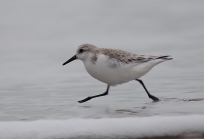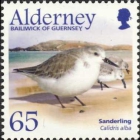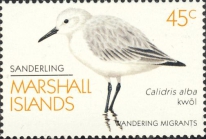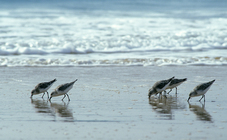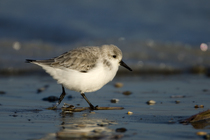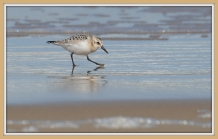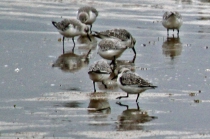WoRMS taxon details
Calidris alba (Pallas, 1764)
159084 (urn:lsid:marinespecies.org:taxname:159084)
accepted
Species
Calidris arenaria · unaccepted
Crocethia alba (Pallas, 1764) · unaccepted
Tringa alba Pallas, 1764 · unaccepted
marine, terrestrial
(of Tringa alba Pallas, 1764) Pallas, P.S. (1764). Avium variarum præcedenti Elencho infertarum, led quae in Syftemate Naturae lllustr. Linnæi nondum extant. <em>Vroeg, A. (ed.). Beredeneerde catalogus van eene, by uitstek fraaye en weergaalooze verzameling, zoo van inlandsche als uitheemsche vogelen, viervoetige en gekorvene dieren.</em> 7 pp., available online at https://www.biodiversitylibrary.org/page/56365380
page(s): 7 [details]
page(s): 7 [details]
Description Length: 19-21 cm. Plumage: pale grey above, white below; grey patch on either side of breast; black shoulder; white bar in...
Distribution North America; southern Nova Scotia to the Gulf States
Description Length: 19-21 cm. Plumage: pale grey above, white below; grey patch on either side of breast; black shoulder; white bar in spread wing; rump white with grey centre stripe and greyish tail; shows partial breeding plumage of rufous above mottles darker. Bare parts: iris brown; bill black, stout; feet and legs black, no hind toe. Habitat: sandy coastal beaches, coral flats and, less often, mudflats and weedy rocky shores. Palearctic migrant. <389><391><393> [details]
Distribution North America; southern Nova Scotia to the Gulf States
Distribution North America; southern Nova Scotia to the Gulf States [details]
WoRMS (2024). Calidris alba (Pallas, 1764). Accessed at: https://www.marinespecies.org/aphia.php?p=taxdetails&id=159084 on 2024-04-20
Date
action
by
![]() The webpage text is licensed under a Creative Commons Attribution 4.0 License
The webpage text is licensed under a Creative Commons Attribution 4.0 License
original description
(of Tringa alba Pallas, 1764) Pallas, P.S. (1764). Avium variarum præcedenti Elencho infertarum, led quae in Syftemate Naturae lllustr. Linnæi nondum extant. <em>Vroeg, A. (ed.). Beredeneerde catalogus van eene, by uitstek fraaye en weergaalooze verzameling, zoo van inlandsche als uitheemsche vogelen, viervoetige en gekorvene dieren.</em> 7 pp., available online at https://www.biodiversitylibrary.org/page/56365380
page(s): 7 [details]
context source (HKRMS) HKBWS. (2013). Hong Kong Bird Report 2011. <em>The Hong Kong Bird Watching Society.</em> [details]
context source (Schelde) Maris, T.; Beauchard, O.; Van Damme, S.; Van den Bergh, E.; Wijnhoven, S.; Meire, P. (2013). Referentiematrices en Ecotoopoppervlaktes Annex bij de Evaluatiemethodiek Schelde-estuarium Studie naar “Ecotoopoppervlaktes en intactness index”. <em>Monitor Taskforce Publication Series, 2013-01. NIOZ: Yerseke.</em> 35 pp. (look up in IMIS) [details]
context source (BeRMS 2020) Research Institute for Nature and Forest (INBO). European Seabirds at Sea - data collected by the Research Institute for Nature and Forest (INBO). INBO Seabird distribution data (all trips). [details]
context source (Bermuda) Amos, E. J. R. (1991). A Guide to The Birds of Bermuda. 206 pp [details]
basis of record Integrated Taxonomic Information System (ITIS). , available online at http://www.itis.gov [details]
additional source Banks, R.C., R.W. McDiarmid, and A.L. Gardner. 1987. Checklist of vertebrates of the United States, the U.S. Territories, and Canada. U.S. Fish and Wildlife Service Resource Publication No. 166. 79 p. [details]
additional source Robbins, C. S. (1983). Golden field Guide to Birds of North America. Golden press. 360p. [details]
additional source Linkletter, L. E. (1977). A checklist of marine fauna and flora of the Bay of Fundy. <em>Huntsman Marine Laboratory, St. Andrews, N.B.</em> 68: p. [details]
additional source Peterson, R.T.; Peterson, V.M. (2002). A field guide to the birds of eastern and central North America. <em>Fifth Edition.</em> Peterson Field Guide Series. Houghton Mifflin Company. New York. 427 p. [details]
additional source Squires, H. J. (1990). Decapod Crustacea of the Atlantic coast of Canada. <em>Canadian Bulletin of Fisheries and Aquatic Sciences.</em> 221: 532 p., available online at http://www.dfo-mpo.gc.ca/library/116743.pdf [details]
additional source Vanner, M. (2003). The encyclopedia of North American birds. <em>Paragon Publishing.</em> 1-383. [details]
additional source Urban, E. K.; Fry, C. H.; Keith, S. (1986). The Birds of Africa, Volume II. <em>Academic Press, London.</em> [details]
additional source Muller, Y. (2004). Faune et flore du littoral du Nord, du Pas-de-Calais et de la Belgique: inventaire. [Coastal fauna and flora of the Nord, Pas-de-Calais and Belgium: inventory]. <em>Commission Régionale de Biologie Région Nord Pas-de-Calais: France.</em> 307 pp., available online at http://www.vliz.be/imisdocs/publications/145561.pdf [details]
additional source King, C.M.; Roberts, C.D.; Bell, B.D.; Fordyce, R.E.; Nicoll, R.S.; Worthy, T.H.; Paulin, C.D.; Hitchmough, R.A.; Keyes, I.W.; Baker, A.N.; Stewart, A.L.; Hiller, N.; McDowall, R.M.; Holdaway, R.N.; McPhee, R.P.; Schwarzhans, W.W.; Tennyson, A.J.D.; Rust, S.; Macadie, I. (2009). Phylum Chordata: lancelets, fishes, amphibians, reptiles, birds, mammals. <em>in: Gordon, D.P. (Ed.) (2009). New Zealand inventory of biodiversity: 1. Kingdom Animalia: Radiata, Lophotrochozoa, Deuterostomia.</em> pp. 431-554. [details]
additional source Gallardo, J. C.; Macías, V.; Velarde, E. (2009). Birds (Vertebrata: Aves) of the Gulf of Mexico. <em>In: Felder, D.L. and D.K. Camp (eds.), Gulf of Mexico–Origins, Waters, and Biota. Biodiversity. Texas A&M Press, College Station, Texas.</em> Pp. 1321–1342. [details]
additional source Liu, J.Y. [Ruiyu] (ed.). (2008). Checklist of marine biota of China seas. <em>China Science Press.</em> 1267 pp. (look up in IMIS) [details] Available for editors [request]
[request]
page(s): 7 [details]
context source (HKRMS) HKBWS. (2013). Hong Kong Bird Report 2011. <em>The Hong Kong Bird Watching Society.</em> [details]
context source (Schelde) Maris, T.; Beauchard, O.; Van Damme, S.; Van den Bergh, E.; Wijnhoven, S.; Meire, P. (2013). Referentiematrices en Ecotoopoppervlaktes Annex bij de Evaluatiemethodiek Schelde-estuarium Studie naar “Ecotoopoppervlaktes en intactness index”. <em>Monitor Taskforce Publication Series, 2013-01. NIOZ: Yerseke.</em> 35 pp. (look up in IMIS) [details]
context source (BeRMS 2020) Research Institute for Nature and Forest (INBO). European Seabirds at Sea - data collected by the Research Institute for Nature and Forest (INBO). INBO Seabird distribution data (all trips). [details]
context source (Bermuda) Amos, E. J. R. (1991). A Guide to The Birds of Bermuda. 206 pp [details]
basis of record Integrated Taxonomic Information System (ITIS). , available online at http://www.itis.gov [details]
additional source Banks, R.C., R.W. McDiarmid, and A.L. Gardner. 1987. Checklist of vertebrates of the United States, the U.S. Territories, and Canada. U.S. Fish and Wildlife Service Resource Publication No. 166. 79 p. [details]
additional source Robbins, C. S. (1983). Golden field Guide to Birds of North America. Golden press. 360p. [details]
additional source Linkletter, L. E. (1977). A checklist of marine fauna and flora of the Bay of Fundy. <em>Huntsman Marine Laboratory, St. Andrews, N.B.</em> 68: p. [details]
additional source Peterson, R.T.; Peterson, V.M. (2002). A field guide to the birds of eastern and central North America. <em>Fifth Edition.</em> Peterson Field Guide Series. Houghton Mifflin Company. New York. 427 p. [details]
additional source Squires, H. J. (1990). Decapod Crustacea of the Atlantic coast of Canada. <em>Canadian Bulletin of Fisheries and Aquatic Sciences.</em> 221: 532 p., available online at http://www.dfo-mpo.gc.ca/library/116743.pdf [details]
additional source Vanner, M. (2003). The encyclopedia of North American birds. <em>Paragon Publishing.</em> 1-383. [details]
additional source Urban, E. K.; Fry, C. H.; Keith, S. (1986). The Birds of Africa, Volume II. <em>Academic Press, London.</em> [details]
additional source Muller, Y. (2004). Faune et flore du littoral du Nord, du Pas-de-Calais et de la Belgique: inventaire. [Coastal fauna and flora of the Nord, Pas-de-Calais and Belgium: inventory]. <em>Commission Régionale de Biologie Région Nord Pas-de-Calais: France.</em> 307 pp., available online at http://www.vliz.be/imisdocs/publications/145561.pdf [details]
additional source King, C.M.; Roberts, C.D.; Bell, B.D.; Fordyce, R.E.; Nicoll, R.S.; Worthy, T.H.; Paulin, C.D.; Hitchmough, R.A.; Keyes, I.W.; Baker, A.N.; Stewart, A.L.; Hiller, N.; McDowall, R.M.; Holdaway, R.N.; McPhee, R.P.; Schwarzhans, W.W.; Tennyson, A.J.D.; Rust, S.; Macadie, I. (2009). Phylum Chordata: lancelets, fishes, amphibians, reptiles, birds, mammals. <em>in: Gordon, D.P. (Ed.) (2009). New Zealand inventory of biodiversity: 1. Kingdom Animalia: Radiata, Lophotrochozoa, Deuterostomia.</em> pp. 431-554. [details]
additional source Gallardo, J. C.; Macías, V.; Velarde, E. (2009). Birds (Vertebrata: Aves) of the Gulf of Mexico. <em>In: Felder, D.L. and D.K. Camp (eds.), Gulf of Mexico–Origins, Waters, and Biota. Biodiversity. Texas A&M Press, College Station, Texas.</em> Pp. 1321–1342. [details]
additional source Liu, J.Y. [Ruiyu] (ed.). (2008). Checklist of marine biota of China seas. <em>China Science Press.</em> 1267 pp. (look up in IMIS) [details] Available for editors
 Present
Present  Present in aphia/obis/gbif/idigbio
Present in aphia/obis/gbif/idigbio  Inaccurate
Inaccurate  Introduced: alien
Introduced: alien  Containing type locality
Containing type locality
From other sources
Description Length: 19-21 cm. Plumage: pale grey above, white below; grey patch on either side of breast; black shoulder; white bar in spread wing; rump white with grey centre stripe and greyish tail; shows partial breeding plumage of rufous above mottles darker. Bare parts: iris brown; bill black, stout; feet and legs black, no hind toe. Habitat: sandy coastal beaches, coral flats and, less often, mudflats and weedy rocky shores. Palearctic migrant. <389><391><393> [details]Dimensions Length: 8" (20cm) [details]
Distribution North America; southern Nova Scotia to the Gulf States [details]
Reproduction Breeds in the arctic regions of Eurasia as well as in North America. In America it Breeds in Greenland, and on the arctic islands and adjacent mainland of Canada south to Southampton Island. Winters from southern New England on the Atlantic coast, and southern part of South America. [details]
| Language | Name | |
|---|---|---|
| Albanian | gjelaci i rërës | [details] |
| Bulgarian | Трипръст брегобегач | [details] |
| Danish | sandløber | [details] |
| Dutch | drieteenstrandloper | [details] |
| English | sanderling | [details] |
| French | bécasseau sanderling | [details] |
| German | Sanderling | [details] |
| Hebrew | חופית לבנה | [details] |
| Japanese | ミユビシギ | [details] |
| Lithuanian | smiltinukas | [details] |
| Modern Greek (1453-) | Λευκοσκαλίδρα | [details] |
| Norwegian Bokmål | sandløper | [details] |
| Norwegian Nynorsk | sandløpar | [details] |
| Polish | piaskowiec | [details] |
| Romanian | nisipar | [details] |
| Scottish Gaelic | luathrán | [details] |
| Slovenian | peščenec | [details] |
| Spanish | correlimos tridáctilo | [details] |
| Swedish | sandlöpare | [details] |
| Turkish | ak kum kuşuak kum kusu | [details] |
| Ukrainian | Побережник білийПесчанка | [details] |
| Welsh | pibydd y tywod | [details] |
To Barcode of Life (28 barcodes)
To Biodiversity Heritage Library (117 publications)
To Biological Information System for Marine Life (BISMaL)
To European Nucleotide Archive (ENA)
To GenBank (82 nucleotides; 87 proteins)
To Global Biotic Interactions (GloBI)
To IUCN Red List (Least Concern)
To PESI
To ITIS
To Biodiversity Heritage Library (117 publications)
To Biological Information System for Marine Life (BISMaL)
To European Nucleotide Archive (ENA)
To GenBank (82 nucleotides; 87 proteins)
To Global Biotic Interactions (GloBI)
To IUCN Red List (Least Concern)
To PESI
To ITIS
